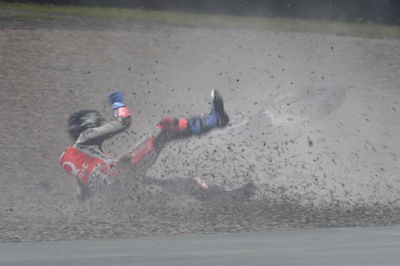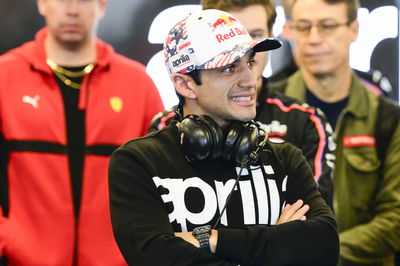Riders who changed the face of GP racing
From Mike Hailwood and Giacomo Agostini to Valentino Rossi and Marc Marquez, lots of riders have truly revolutionised world championship motorcycle racing over the years.
Some were more successful in terms of races or championships won, some were definitely more famous, and certainly some were financially far better off or had much longer careers.
We look at the men whose talent - on the track or off - brought real changes to the sport and what they did that made a real difference - in chronological order of their first major wins...
 |
Lancashire lad Geoff Duke is the man credited for being the pioneer of the one-piece leather race suit. He was certainly the first big star to realise the safety and aerodynamic advantages of one-piece leathers, and famously commissioned a tailor in St.Helens to make a tight-fitting one-piece set of leathers with no padding or pockets.
He was measured up while in a crouched position, and the leathers weighed far less than the bulky two-piece kit his rivals wore. Duke used them to his advantage as he won six World Championships and six Isle of Man TT races during the 1950s.
 |
| (Pic: Gold & Goose). |
Mike "The Bike" Hailwood is often hailed as one of the greatest riders of all time. He may not have won as many titles as others - although 76 GP victories and nine world titles in the four classes of 125, 250, 350 and 500 is hardly shabby. But Hailwood's impact on the sport was huge as many were just in awe of his natural talent.
Hailwood is the man who extended the career of racers, starting at a younger age than just about all of his rivals and extending his career until he was older than most of the racers he faced.
When the vast majority of riders didn't start motorcycling until they were 16 as kids' bikes just didn't exist, Hailwood's dad made him a small bike and he rode it every day.
Those early years taught him how to ride on any surface on a rudimentary machine, and those skills transferred when he went GP racing. He could get on any bike, ride around its shortcomings and still win, He didn't need the best bike.
In 1978, after 11 years away from racing bikes, the 38-year-old Hailwood went back to the Isle of Man and won the Formula One race on a Ducati. He retired a year later, age 39. And then was killed in a road traffic accident two years later.
 |
In terms of racing success, Italian Giacomo Agostini is top of the list - the most successful racer of all time. He won 15 world titles from 1966 to 1975, champion on both 350s and 500s for five years running between 1968 and 1972.
And as it was a time when the Isle of Man TT was part of the world championship, he won a staggering 10 of those too. Ago won 122 grands prix in total - a record that Valentino Rossi, with 114, is chasing hard.
But perhaps what Ago did to change racing was to herald in the era of the modern two-stroke. MV Agusta had won every 500cc world title from 1958 until 1974. But instead of staying with a winning team, Agostini jumped ship to Yamaha and their two-stroke, and took it to the 1975 world championship title.
It was a first for Yamaha and a two-stroke, and started the dominance of the Japanese 500cc two-smokers that lasted until the introduction of MotoGP four-strokes 27 years later.
 |
| (Pic: Gold & Goose). |
For a man who only won two world championships and 19 GPs, Barry Sheene's impact on the sport was huge. He was the first true global superstar of motorcycle racing, equally likely to make the front page of the tabloids as well as the sports pages at the back for his exploits on and off the track.
He was the cheeky cockney who personified the everyday geezer made good, doing what most ordinary blokes would do if they had the trappings of success that Sheene had. Dating models, partying around the globe with famous pals like James Hunt and George Harrison and gadding about in a helicopter. He loved a beer and a fag, and even had a hole in the front of helmet to have a sly drag while on the grid.
He famously was caught on TV cameras giving the V-sign to Kenny Roberts at the British GP and loved to prank around.
But probably what endeared him the most to his fans was his ability to cheat death and still come back and race again. He was often dubbed the bionic man due to the metalwork in his body after two major smashes - one at Daytona when his tyre exploded in 1975 and again in a fireball horror at the British GP seven years later. Both times he was warned he may not walk again, and both times he was back on a bike within weeks.
Sheene was famous for being tough and determined despite adversity which moved his earnings and fame into the stratosphere.
 |
| (Pic: Gold & Goose). |
Triple world champ Kenny Roberts has done more to shape modern motorcycle racing than anyone on the planet. He totally transformed the sport in terms of rider safety, paddock conditions, rider pay, motorcycle technology and racing technique. That's before even mentioning his individual success as a rider - America's first world champion. And the first man to have a son who was also a premier-class world champion.
After winning American flat track titles, King Kenny packed his bags for Europe to contest road racing - bringing with him the fierce competitiveness that you need to succeed in the cut and thrust of dirt ovals.
He popularised a whole new way or riding, hanging off and dragging a knee in corners and backing it in, dirt track style. Until Roberts, GP riders largely stayed well tucked in and looked for smooth lines. Some riders had experimented with hanging off - like John Surtees - but the bike technology just wasn't up to it.
But by the late 1970s, bikes and tyres had moved on so much that Roberts used to put duct tape on his knees to drag them in corners, and even back it in to corners.
Roberts was instrumental in getting dangerous circuits thrown out of the calendar, and improving safety and paddock conditions as well as making sure riders got paid handsomely.
He also took GP racing to the USA by developing the Laguna Seca track, then pioneered electronics and computers on his own bikes, running his own team with factory support, then building his own MotoGP bikes. This formed the blueprint for all the teams in MotoGP today.
 |
| (Pic: Gold & Goose). |
When it comes to displaying natural talent for riding a bike, then certain names come up with remarkable regularity - like Casey Stoner and Kevin Schwantz. But none more so than legendary American "Fast" Freddie Spencer, a man who learned his skills play riding in his native Louisiana.
He just loved riding, and experimenting skidding around on a bike, learning about lean angles, traction, gyroscopic effects and more. Of course, he didn't think of it in such scientific terms, he just learned what affected the bike and how fast he could go.
So when he started racing aged 15 and beat Gary Nixon, he was spotted by legendary tuner and team owner Erv Kanemoto. They teamed up, and Spencer started winning American championships before the pair went to GPs, helping Honda develop the three-cylinder NS500.
Spencer became the youngest-ever 500 GP winner when he beat Barry Sheene and Franco Uncini at Spa in July 1982. A year later, the 21-year-old beat Mike Hailwood's record in becoming the youngest ever world champion in the premier class. It's a record that stood until Marc Marquez did the deed in 2013, aged just 20. Then two years later Spencer became the only man ever to win the 250 and 500 titles in the same year.
Machinery issues and bad decisions meant he'd never win another world championship title, but Spencer continued racing for lots of different manufacturers, in lots of different series, for another decade.
 |
| (Pic: Gold & Goose). |
What sets Valentino Rossi apart from his rivals in not necessarily his amazing natural talent or even his record of 88 GP wins in the premier class, but how he has adapted and reinvented himself several times in such a lengthy and successful career.
It's been 20 years since The Doctor hit the scene on his screaming Aprilia 125, and he's still winning races at the very highest level today. He's gone from winning world championships on 125, 250s and 500 two-strokes to every incarnation of MotoGP four-strokes. He's won on Hondas and Yamahas, and even had a fair crack at giving Ducati another MotoGP title.
In his time he's faced the greats who have spanned the generations of GP riders - from Loris Capirossi right through to Marc Marquez. And he's had huge rivalries with riders like Max Biaggi, Jorge Lorenzo and Marquez, too.
While others have fallen by the wayside, Rossi has kept on with dogged determination and focus on winning.
That's despite the massive trappings of success and global superstardom that sees him followed around the globe by an army of yellow-wearing fans. He's one of the world's highest-paid sportsmen yet still keeps his personal life very private and somehow retains the focus he needs to remain competitive as he nears 40 years of age.
 |
| (Pic: Gold & Goose). |
Spaniard Marc Marquez has been smashing records ever since he hit the world championships. Like Mike Hailwood, Phil Read and Giacomo Agsotini, he's a rider who has won world championship titles in three different classes.
And of course when he switched up to MotoGP he became the first rider since Kennby Roberts in 1978 to win the premier class in his first season, and also he became the youngest ever winner when he took the MotoGP crown age just 20 in 2013. And then he repeated the feat a year later, riding with total dominance to win ten races in a row and clinch the crown with three races remaining.
Apart from his precocious talent, Marquez has popularised the next level of riding by getting his elbow down. Of course, he wasn't the first to do it - Frenchman Jean-Phillipe Ruggia used to do it at the end of the 1980s and even had elbow scrapers fitted to his leathers. And lots of other riders of the modern age have also done it as tyre technology now lets them get to ridiculous lean angles.
But Marquez was the first rider to really use it as a weapon. His extreme hang-off technique allows him to run less lean angle in the turns, and get the bike more upright onto the fatter part of the tyre more quickly when exiting corners. So he can get on the gas harder. It's the next generation of riding.











